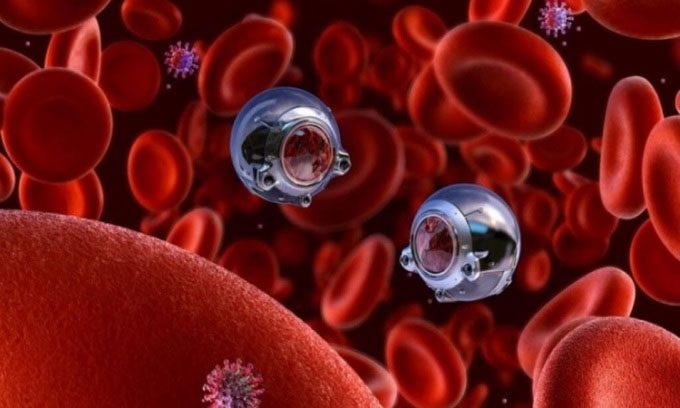Researchers Create Self-Moving Particles Using Protein Motors to Transport Drugs Through Body Fluids
Samuel Sánchez, a scientist at the Institute of Bioengineering of Catalonia in Barcelona, believes that nano-robots could transport cancer medications or antibiotics through the body’s mucus. He uses spherical silica particles as a chassis. On the surface of these particles are special proteins that propel them through liquids like tiny motors. In a study published in the journal ACS Nano, Sánchez collaborated with researchers in antibiotic medicine. They placed experimental antibiotics on silica nano-robots, including drugs extracted from bee venom, to treat wounds in mice. The nano-robots were deployed at one end of an infected wound and moved through the skin to treat the entire area. This is the first report of nano-robots effectively eliminating bacteria in animals.

Simulation of the robot swimming around the wound. (Photo: TechnoBarg).
“We observed that the entire wound gradually healed. The machine could move around the wound and clean the infection,” said César de la Fuente, a biological engineer at the University of Pennsylvania, who leads the project alongside Sánchez.
Sánchez designed the nano-robots to deliver drugs to infections within viscous fluids like sebum. According to him, areas with high viscosity or low diffusion are where robotic movement is needed.
Sánchez’s research team created two sizes of robots from silica dioxide, including slightly larger nano and micro-particles. They used a protein called urease to propel the particles. Urease is an enzyme that converts urea in the body into ammonia and carbon dioxide. Similar to a car engine, this enzyme transforms chemical reactions into mechanical energy. Urea serves as the fuel. Sánchez shared that the secret lies in covering the robots with motors arranged asymmetrically. This allows the robots to move chaotically from the starting point rather than just running in circles.
De la Fuente’s laboratory provided experimental antibiotics, including LL-37, a long natural antimicrobial peptide, and K7-Pol, a shorter synthetic peptide derived from bee venom. Both degrade bacterial cell membranes, rendering them inactive. In the lab, K7-Pol has effects against parasites and cancer cells.
Next, the research team demonstrated that the robots could swim. In test tubes containing urea, the robots achieved speeds of up to 4 micrometers per second. Subsequently, some mice were injected with LL-37-carrying robots, while others received K7-Pol-carrying robots. Wounds treated only with antibiotics without the robots showed localized recovery. The bacterial count decreased by 100 to 1,000 times, but only at the site where the drug was applied. The rest of the wound progressed as if it had not been treated. However, the nano-robots carrying antibiotics not only treated the entire wound but also reduced the bacterial count by 100 to 1,000 times to a level manageable by the immune system.



















































